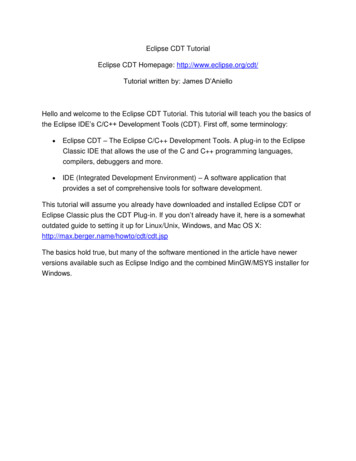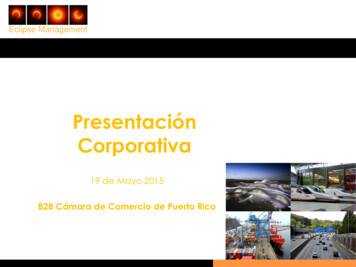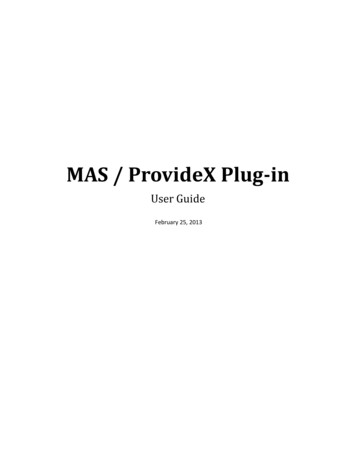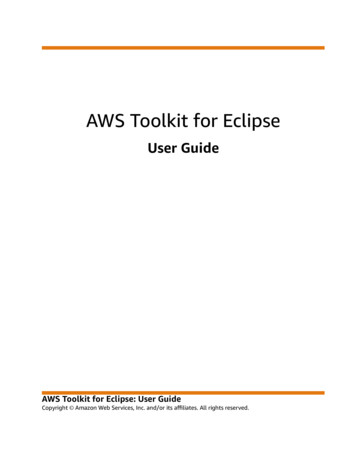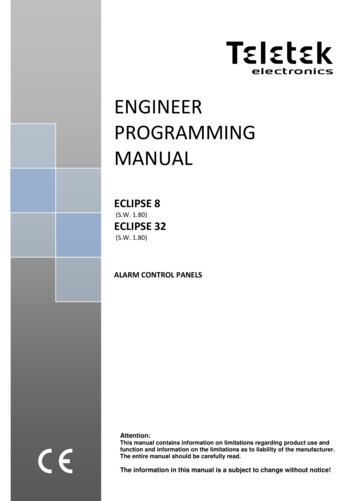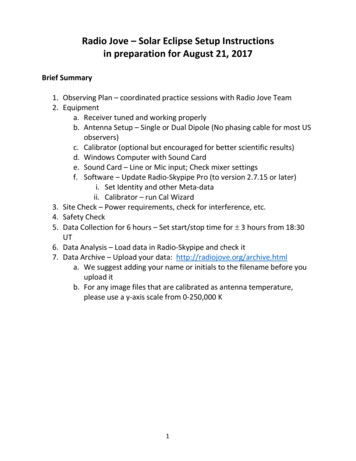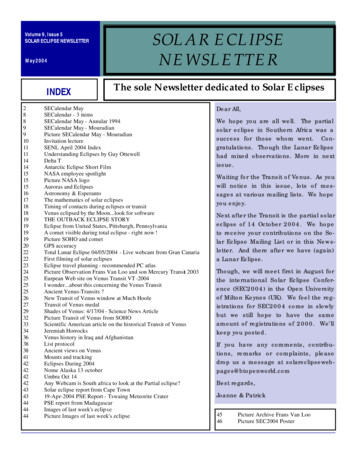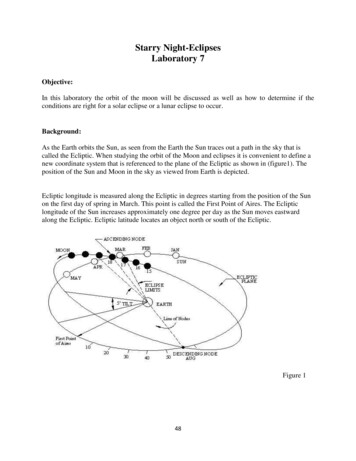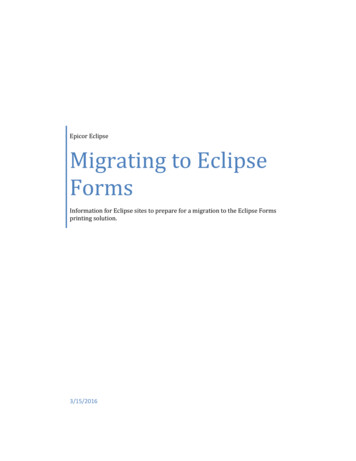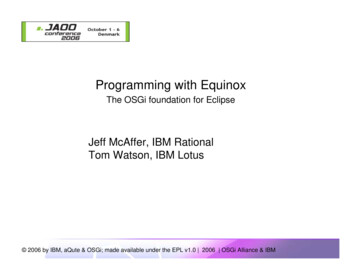
Transcription
Programming with EquinoxThe OSGi foundation for EclipseJeff McAffer, IBM RationalTom Watson, IBM Lotus 2006 by IBM, aQute & OSGi; made available under the EPL v1.0 2006 OSGi Alliance & IBM
Contents 1SetupIntroduction to OSGiManaging your Target EnvironmentThe Equinox/OSGi Development ModelOSGi BasicsComponentsServicesRemotingConclusionOSGi Component Programming 2006 by IBM, aQute & OSGi; made available under the EPL v1.0
Your Infrastructure You need to have the following software installed on your machinein a new workspace: Eclipse SDK 3.2 (http://eclipse.org) The tutorial projects from CVS: .org/cvshome/bundlesapachecon2006Select all projects under TutorialOSGi Component Programming 2006 by IBM, aQute & OSGi; made available under the EPL v1.0
Loading the tutorial projects from CVS Window Open Perspective Other CVS Repository Exploring In CVS Repository view context menu: New Repository Location Fill in the necessary CVS Repository information In CVS Repositories view, expand: HEAD/Tutorial Select all projects under Tutorial and choose Check Out3OSGi Component Programming 2006 by IBM, aQute & OSGi; made available under the EPL v1.0
Your Workspace (more or less)4OSGi Component Programming 2006 by IBM, aQute & OSGi; made available under the EPL v1.0
Section I - OSGi Background5OSGi Component Programming 2006 by IBM, aQute & OSGi; made available under the EPL v1.0
What is the OSGi service platform? A JavaTM framework for developing remotely deployed serviceapplications, that require: Reliability Large scale distribution Wide range of devices Collaborative 6Created through collaboration of industry leadersSpec 4.0 publicly available at www.osgi.org The Dynamic Modularity Layer for Java!Cool!OSGi Component Programming 2006 by IBM, aQute & OSGi; made available under the EPL v1.0
Why the OSGi Service Platform? What problems does the OSGi Service Platform address? A unified software market: The limited (binary) software portability problem The complexity of building heterogeneous software systems Supporting the myriad of configuration, variations, andcustomizations required by today’s software and hardware Managing the software life-cycle7OSGi Component Programming 2006 by IBM, aQute & OSGi; made available under the EPL v1.0
Limited Binary Software Portability Lack of portability causes Market friction: No large market of reusable components andapplications Reduced quality Unnecessary constraints on hardware and software architectures CPUs differ widely in cost and performance LinuxTM is nice, but it is sub-optimal for smaller devices Benefits of the OSGi Platform Applications run unmodified on different hardware and softwarearchitectures8OSGi Component Programming 2006 by IBM, aQute & OSGi; made available under the EPL v1.0
Complexity of Software A DVD player can contain 1 Million lines of code Comparison: Space Shuttle 0.5 Million A BMW car can contain up to 50 networked computerizeddevices Eclipse contains 2.5 million lines of code An average programmer writes an average of 10 lines a day Houston we have a problem9OSGi Component Programming 2006 by IBM, aQute & OSGi; made available under the EPL v1.0
Complexity of SoftwareProductivityService Oriented ProgrammingStructuredProgrammingAssemblyComplexity and Size10OSGi Component Programming 2006 by IBM, aQute & OSGi; made available under the EPL v1.0
Limits Object Oriented Technology Objects are great, but oh, thetangled webs we weaves Coupling severely limitsreusability Using a generic object, can dragin a large number of other objects Creates overly large systemsafter a certain complexity isreached Flexibility must be built in by theprogrammer Plug-in architectures11OSGi Component Programming 2006 by IBM, aQute & OSGi; made available under the EPL v1.0
Service Oriented Architectures Separate the contract from theimplementation Allows alternate implementations Dynamically discover and bindavailable implementations Based on contract (interface) Components are reusable Not coupled to implementationdetails12Service ContractprovidesComponentOSGi Component Programming 2006 by IBM, aQute & OSGi; made available under the EPL v1.0uses
Framework Allows applications to share asingle Java VMClassloadingIsolation/SecurityCommunication &Collaborations betweenapplicationsLife cycle managementPolicy free 13Policies are provided bybundlesAPI is fully self managedApplicationThe LibraryOSGiOSGiWebOSGiJTAPI3DOSGiServerThe System ClassLibrariesJavaMediaJavaVMImaging JavaSQLFWVMJavaVMOperating SystemCryptoDirecCrypto- VMDirecUPnP SystemOperatinggraphyOperating SystemtoriesOperating SystemJavaJavaVMVMOperating SystemOperating SystemOSGi Component Programming 2006 by IBM, aQute & OSGi; made available under the EPL v1.0USBMathTCP/IPDistriDistributedGUI
LayeringLife CycleSecurityApplicationsServicesModuleExecution Environment14OSGi Component Programming 2006 by IBM, aQute & OSGi; made available under the EPL v1.0
Execution Environment OSGi APIs only use a subset ofJ2SE and J2ME CDC OSGi Minimum EE Matches most profiles Implementations can use morethan the OSGi Minimum EE Security is not mandatory CLDC is possible if class loadersare added in a device specificwayCLDC/MIDPOSGiMin.J2SECDC/FP15OSGi Component Programming 2006 by IBM, aQute & OSGi; made available under the EPL v1.0
Module Layer Packaging of applications andlibraries in Bundles Raw Java has significant deploymentissues Class Loading modularization Raw Java provides the Class Path asan ordered search list, which makes ithard to control multiple applicationsbundlebundlebundle Protection Raw Java can not protect certainpackages and classesbundlebundle Versioning Raw Java can not handle multipleversions of the same packagebundlebundle16OSGi Component Programming 2006 by IBM, aQute & OSGi; made available under the EPL v1.0
Life Cycle Layer System Bundle represents theOSGi Framework Provides an API for managingbundlesSystembundlebundleM Install Resolve StartBundleX-v2X Stop Refresh Update Uninstall Based on the module layer17BundleABundleBOSGi Component Programming 2006 by IBM, aQute & OSGi; made available under the EPL v1.0
Life Cycle Layer Bundle is started by the BundleActivator class Header in Manifest refers to thisclass Interface has 2 methodsINSTALLEDSTARTING Start: Initialize and return immediate Stop: Cleanup The Activator gets a Bundle Contextthat provides access to theFramework functions Framework provides Start Levelservice to control the start/stop ofgroups of Gi Component Programming 2006 by IBM, aQute & OSGi; made available under the EPL v1.0STOPPING
Service Layer Provides an in-VM service model Discover (and get notified about) services based on their interfaceor properties Bind to one or more services by program control, default rules, or deployment configuration SOA Confusion Web services bind and discover over the net The OSGi Service Platform binds and discovers inside a Java VM The OSGi Alliance provides many standardized services19OSGi Component Programming 2006 by IBM, aQute & OSGi; made available under the EPL v1.0
Planned R4MobileEvolutionR3VehicleHome AutomationUPnPR1FrameworkHttpLogDevice Access200020PackageR2AdminConfiguration AdminPermission AdminUser AdminPreferencesMetaTypeService TrackerInitial ProvisioningName SpaceJiniStart LevelIO ConnectorWire AdminXML ParserMeasurement & StatePositionExecution Env.Application ManagerMIDP ContainerSigned BundlesDeclarative ServicesPower ManagementDevice ManagementSecurity PoliciesUPnP ExporterDiagnostics/MonitoringFramework LayeringInitial ProvisioningUPnP 200120032005OSGi Component Programming 2006 by IBM, aQute & OSGi; made available under the EPL v1.0
Benefits of Using the OSGi Service Platform Components are smaller Easier to make Components are not coupled to other components Gives reusability Excellent model for the myriad of customizations and variationthat are required of today’s devices Collaborative model Allows reuse of other components for most problems21OSGi Component Programming 2006 by IBM, aQute & OSGi; made available under the EPL v1.0
Section II – Equinox and Eclipse22OSGi Component Programming 2006 by IBM, aQute & OSGi; made available under the EPL v1.0
What is Equinox ? An open source community focused on OSGi Technology http://www.eclipse.org/equinox/ Develop OSGi specification implementations Prototype ideas related to OSGi An OSGi Framework implementation Core of the Eclipse runtime Provides the base for Eclipse plug-in collaboration Fully compatible with the OSGi R4 specification New for Eclipse 3.2 – Other specification implementations Device Manager, Declarative Services, Event Admin, HTTP Service, LogService, Metatype Service, Preferences Service, User Admin, Wire Admin– More on the way!!23OSGi Component Programming 2006 by IBM, aQute & OSGi; made available under the EPL v1.0
The Equinox Target EnvironmentBundle A{} Eclipse makes it easy to develop for allOSGi Service Platforms A target platformInstall Contains a set of bundles Defines runtime parametersBundle B{} To Define the Target Platform, goto: Preferences - Plug-in Development Target Platform Select the target project in yourworkspace as location Advanced target management using“Target Definitions” (New- Other- Plugin Development- Target Definition)24Bundle c{}Bundled{}Bundle F{}BundleG{}Bundle E{}TargetOSGi Framework(Equinox)OSGi Component Programming 2006 by IBM, aQute & OSGi; made available under the EPL v1.0
Setting up the Target Platform25OSGi Component Programming 2006 by IBM, aQute & OSGi; made available under the EPL v1.0
What Did We Learn The OSGi Service Platform is kind of a Java Operating System It simplifies: Deployment Problems Software composition Software management Eclipse provides a development environment for OSGi Bundles Equinox provides open source implementations of the OSGispecifications in the Equinox project26OSGi Component Programming 2006 by IBM, aQute & OSGi; made available under the EPL v1.0
Section III - Fundamental OSGi concepts27OSGi Component Programming 2006 by IBM, aQute & OSGi; made available under the EPL v1.0
Framework EntitiesOSGi FrameworkBundle A{}Bundle B{}Bundle C{}28 service, java interfaceOSGi Component Programming 2006 by IBM, aQute & OSGi; made available under the EPL v1.0
Bundles A bundle is the deliverable application Like a WindowsTM EXE file Content is a JAR file A bundle registers zero or more services A service is specified in a Java interface and may be implementedby multiple bundles Services are bound to the bundle life-cycle Searches can be used to find services registered by otherbundles Query language29OSGi Component Programming 2006 by IBM, aQute & OSGi; made available under the EPL v1.0
What is in a Bundle? A Bundle contains (normally in a JAR file): Manifest Code Resources The Framework: Reads the bundle’s manifest Installs the code and resources Resolves dependenciesBundle A{} During Runtime: 30Calls the Bundle Activator to start the bundleManages java classpathHandles the service dependenciesCalls the Bundle Activator to stop the bundleOSGi Component Programming 2006 by IBM, aQute & OSGi; made available under the EPL v1.0
Create the Hello World bundleStep 1.Create new plug-in projectStep 2Project name: helloworldan OSGi framework: standard31Step 3Generate an activatorStep 4Use the Hello OSGi BundletemplateOSGi Component Programming 2006 by IBM, aQute & OSGi; made available under the EPL v1.0
Real code! Hello World (and Goodbye)HelloWorld.java The wizard has generated thecode on the left This class implements theBundleActivator so that theFramework can start/stop theclass The activator is referenced in themanifestpackage helloworldpublic class HelloWorldimplements BundleActivator {public void start(BundleContext context)throws Exception{System.out.println("Hello world!!");}public void stop(BundleContext context)throws Exception {System.out.println("Goodbye world!!");}}32OSGi Component Programming 2006 by IBM, aQute & OSGi; made available under the EPL v1.0
Real code! Hello World (and Goodbye) The Manifest (in METAINF/MANIFEST.MF) is alsogenerated by the wizard Eclipse provides convenient editorsfor the manifest For the source: click onMANIEST.MF Notice: Bundle-Activator (used to notify thebundle of lifecycle changes)META-INF/MANIFEST.MFManifest-Version: 1.0Bundle-ManifestVersion: 2Bundle-Name: Helloworld Plug-inBundle-SymbolicName: helloworldBundle-Version: 1.0.0Bundle-Localization: Package:org.osgi.framework;version "1.3.0" Import-Package (dependencies)33OSGi Component Programming 2006 by IBM, aQute & OSGi; made available under the EPL v1.0
Eclipse Launch Configuration The Launch Configuration is prepared for you Run - Run - EclipseTutorial Deselect “Workspace Plug-ins” and “Target Platform” checkbox This removes all possible bundles from the launch configuration Select the helloworld bundle and Select “Add Required Plug-ins” This calculates from the dependency information, which bundlesare required to run our helloworld example34OSGi Component Programming 2006 by IBM, aQute & OSGi; made available under the EPL v1.0
Equinox Launch Configuration35OSGi Component Programming 2006 by IBM, aQute & OSGi; made available under the EPL v1.0
Run the Hello World bundle Press Run The Framework is a consoleapplication The Framework now runs thehelloworld example See the printed text It also runs a Framework console Equinox specific Type “ss” (show status) Look at the active bundles Notice the number for the helloworldbundle. This is the bundle id. Type “stop symbolic-name ”36OSGi Component Programming 2006 by IBM, aQute & OSGi; made available under the EPL v1.0
Self-Hosting Bundle Projects Normally, a bundle is packaged in aJAR fileJAR file layoutfile:c;/ META-INF/MANIFEST.MFhelloworld/HelloWorld.class The traditional edit-compile-debugcycle. Self-Hosting Allows for quickdebugging of bundle codeTarget Platform No packaging steps No deployment steps Just code/save/run Some changes require update of thebundle in the Framework Console:update symbolic-name Project Layoutreference:file:C:/ in dir content automatically added to rootComplied into bin directory, non java files copied37OSGi Component Programming 2006 by IBM, aQute & OSGi; made available under the EPL v1.0
Creating deployable bundles – how it works The build.properties file specifies thecontent of the bundle jar Specifies the source and output folders of thedifferent libraries source. – The source directory of the project.Used for compilation and resources. output. – The output directory where classfiles and resources are copied tobuild.propertiessource. src/output. bin/bin.includes META-INF/,\. bin.includes – What is included in the JARfrom the project directory38OSGi Component Programming 2006 by IBM, aQute & OSGi; made available under the EPL v1.0
Export Export the content of a project into abundle jar Bundle jars can be installed acrossmultiple OSGi Frameworkimplementations The Deployable plug-ins andfragments wizard can be used togenerate a bundle jar from a project. File - Export - Deployable plug-insand fragments39OSGi Component Programming 2006 by IBM, aQute & OSGi; made available under the EPL v1.0
What Did We Learn The unit of deployment of an OSGi Service Platform The Eclipse Target Environment How to launch an Equinox environment with a defined set ofbundles How to start/stop bundles How the Equinox console works How the classpath is managed for self hosted bundles40OSGi Component Programming 2006 by IBM, aQute & OSGi; made available under the EPL v1.0
Section IV – Component interaction and collaboration41OSGi Component Programming 2006 by IBM, aQute & OSGi; made available under the EPL v1.0
Collaborative model OSGi is more than an Applet, MIDlet, Xlet runnerBundles can collaborate through: service objects package sharing A dynamic registry allows a bundle to find and track serviceobjectsFramework fully manages this collaboration Dependencies, security42OSGi Component Programming 2006 by IBM, aQute & OSGi; made available under the EPL v1.0
Collaborative modelOSGi esJAVAOperating SystemHardware43OSGi Component Programming 2006 by IBM, aQute & OSGi; made available under the EPL v1.0
Collaborative modelJava Application ManagerNo management packagesMidlet,Xlet,orAppletNo collaborationNo package management(versions!)JAVAOperating SystemNo native codeHardware44OSGi Component Programming 2006 by IBM, aQute & OSGi; made available under the EPL v1.0
Classpath issues Java applications consists of classesplaced in packagesJava searches for a package or class indifferent jar files and directories q-1.0prpAn OSGi Framework is a network ofclass loaders. These are usually specified in theCLASSPATH environment variableqqParameterized by the Manifest headersAny dependencies between bundles areresolved by the FrameworkIt is possible to fetch bundles on demandComplicated – But an OSGi Frameworkmakes it painless to useBundleWireExported packageConstraintExported package45q-2.0OSGi Component Programming 2006 by IBM, aQute & OSGi; made available under the EPL v1.0
OSGi dependency ice.httpBundle AExport mport org.osgi.service.httpjavax.servlet.httpBundle BExport gi.service.logImport org.osgi.service.http46A resolvedB resolvedOSGi Component Programming 2006 by IBM, aQute & OSGi; made available under the EPL v1.0
Package or Bundle Dependencies? The OSGi Specifications supports bothRequire-Bundle and Import-Package Require-Bundle creates a dependency ona complete bundle Simple to use Imports packages that are not used Import-Package creates a dependency onjust a package Creates less brittle bundles because ofsubstitutability More cumbersome to use (Tools!) In almost all cases, Import-Package isrecommended because it easesdeployment and version migration The specifications detail a number ofadditional problems with OSGi Component Programming 2006 by IBM, aQute & OSGi; made available under the EPL v1.0
discoverService Specificsregisterbind 48A service is an object registered with theFramework by a bundle to be used byother bundlesThe semantics and syntax of a service arespecified in a Java interfaceA bundle can register a service.A bundle can use a service (bind to) 1.1 0.1 0.nA service can be discovered dynamicallyServices can go away at any time!servicepackage org.osgi.service.log;import org.osgi.framework.ServiceReference;public interface LogService {public static final int LOG ERROR 1;public static final int LOG WARNING 2;public static final int LOG INFO 3;public static final int LOG DEBUG 4;public void log(int level, String message);public void log(int level,String message, Throwable exception);public void log(ServiceReference sr,int level, String message);public void log(ServiceReference sr,int level, String message,Throwable exception);}OSGi Component Programming 2006 by IBM, aQute & OSGi; made available under the EPL v1.0
Services continued The Framework Service Registry is available to all bundles to collaborate with otherbundlesDifferent bundles (from different vendors) can implement the same interface OSGi defines a standard set of services Under Operator controlServices are associated with properties 49Other organizations can define more (AMI-C)Extensive notifications for service life cyclesServices have a unique idServices require permission Implementation is not visible to usersAllows operator to replace implementations without disrupting serviceQuery language to find appropriate serviceBundles can update the propertiesOSGi Component Programming 2006 by IBM, aQute & OSGi; made available under the EPL v1.0
Manipulating Services The BundleContext provides themethods to manipulate the serviceregistry Service registrations are handled byServiceRegistration objects They can be used to unregister aservice or modify its properties Service References give access tothe service as well as to the service’sproperties Access to service objects is throughthe getService method. Theseservices should be returned with theungetService method50ServiceRegistration registerService(String clazz,Object service,Dictionary String clazz,String filter)Object getService(ServiceReference reference)boolean ungetService(ServiceReference reference);OSGi Component Programming 2006 by IBM, aQute & OSGi; made available under the EPL v1.0
What Did We Learn The OSGi Service Platform provides a collaboration model that isbased on Services Package sharing Sharing is complicated, but the well defined specifications reducethe complexity for bundle developers Services provide a very powerful dynamic programming model51OSGi Component Programming 2006 by IBM, aQute & OSGi; made available under the EPL v1.0
Section V – Service Components52OSGi Component Programming 2006 by IBM, aQute & OSGi; made available under the EPL v1.0
Components Simplify Service ProgrammingMETA-INF/MANIFEST.MF The dynamic nature of services makeprogramming more complicated The declarative service model simplifieshandling these dynamics Dependencies are defined in an XML file Declarative Services: Optionally Depend on one or more services Optionally Provide a service Optionally lazy initialized Configurable Example shows a hello world bundle thatlogs Hello and Goodbye First add dependencies by selectingMANIFEST.MF, on the Dependencies tab Add the component and log package53Manifest-Version: 1.0 Import-Package: /component.xmlOSGI-INF/component.xml ?xml version "1.0" encoding "UTF-8"? component name "hello.component.log" implementationclass "hello.Component"/ reference name "LOG” interface "org.osgi.service.log.LogService"/ /component OSGi Component Programming 2006 by IBM, aQute & OSGi; made available under the EPL v1.0
Import the necessary packagesStep 1 – Add new Imported PackagesStep 2 – Select the necessary packagesStep 3 – Save the bundle manifest54OSGi Component Programming 2006 by IBM, aQute & OSGi; made available under the EPL v1.0
Login Component Source CodeOSGI-INF/component.xml A component can be any class No specific interface The activate and deactivate methods arecalled when the component isactivated/deactivated ?xml version "1.0" encoding "UTF-8"? component name "hello.component.log" implementationclass "hello.Component"/ reference name "LOG"interface "org.osgi.service.log.LogService"/ /component Dependencies must be resolved: Log Service The ComponentContext class providesaccess to the referenced services The locateService methods finds a reference The component instance can be sure thatat any moment in time between activateand deactivate there is a valid Log Service55Component.javapackage hello;import org.osgi.service.component.*;import org.osgi.service.log.*;public class Component {LogService log;protected void activate(ComponentContext context){log (LogService) G INFO, "Hello World"); }protected void deactivate(ComponentContext context){log.log(LogService.LOG INFO, "Goodbye World");}}OSGi Component Programming 2006 by IBM, aQute & OSGi; made available under the EPL v1.0
Add Declarative Services, Log, and Component56OSGi Component Programming 2006 by IBM, aQute & OSGi; made available under the EPL v1.0
Launching Launch the EquinoxTutoriallaunch configuration You can look in the log with thelog command Last event is at bottom Stop the bundle Stop symbolic-name Run log again57OSGi Component Programming 2006 by IBM, aQute & OSGi; made available under the EPL v1.0
What Did We Learn Programming with services is complicated The Declarative Services model makes service programmingmuch simpler How the component XML is constructed We used the Log Service58OSGi Component Programming 2006 by IBM, aQute & OSGi; made available under the EPL v1.0
Section VI – Use Case: Developing a Chat Service59OSGi Component Programming 2006 by IBM, aQute & OSGi; made available under the EPL v1.0
A Chat Service We will now design a service thatsimplifies Chat/Instant Messaging clients We do the clients later, this is just intended tosupport clients. A Chat client should be able tocommunicate with a user through: A window, telnet session, MSN, AOL, Skype,etc. interface. We base the communication between chatclients on a Channel interface. We register a service we receive messagesfrom The registry contains other channel serviceswe can send messages to A property contains the user name For ease of use, we use a commandbased interface for login and annelWindowChatInput channelChannel essionssessionsChannel services60TelnetConnectionsOSGi Component Programming 2006 by IBM, aQute & OSGi; made available under the EPL v1.0
Channel Service DesignChannel.java Create a new project to hold our serviceinterface Call this project myname .chat This is a Plug-in Project The Channel service is one way: Each channel service represents on user We only receive through a channel service A client uses a channel service to send amessage to a specific user The CH NAME service property This property must be registered with theservice The value is the name of the user, e.g. tom A single method send with the followingarguments from – The user name that sends themessage msg – The message to be sendpackage aQute.service.channel;import java.io.*;public interface Channel {String CH NAME "channel.name";void send(String from, String msg)throws IOException;}META-INF/MANIFEST.MFManifest-Version: 1.0Bundle-ManifestVersion: 2Bundle-Name: Chat Plug-inBundle-SymbolicName: aQute.chatBundle-Version: 1.0.0Bundle-Localization: pluginImport-Package:org.osgi.framework;version "1.3.0"Export-Package: aQute.service.channel Export the service channel package61OSGi Component Programming 2006 by IBM, aQute & OSGi; made available under the EPL v1.0
White Board Approach The Channel Service uses the WhiteBoard Approach The White Board approach is: Each Event Listeners (Channels) areregistered as Services Any interested client uses the service to sendevents (messages) toBundle B{}RegistrygetServerbundle62Bundle A{}registerPublisher It is an effective approach to reduce thenumber of couplings between bundles There is a white-paper comparing awhiteboard approach with a nonwhiteboard approach.Bundle C{}OSGi Component Programming 2006 by IBM, aQute & OSGi; made available under the EPL v1.0Events: register,unregister,modified
Telnet Based Chat Client The best way to start is to design a smalltest program. The easiest way to a “UI” is a telnet serverthat uses the Channel service tocommunicate with siblings This also shows how Internet servers shouldbe constructedThreadThreadActivated byDeclarative ServicesLogServiceLogService The telnet Chat server will create aHandler for each opened session. The Handler is a thread that waits for inputfrom the user The Handler registers a Channel.TelnetChatTelnetChat1*UserFor each sessionHandlerHandler The Handler is stopped when the sessioncloses. This unregisters the Channel serviceChannelChannel63OSGi Component Programming 2006 by IBM, aQute & OSGi; made available under the EPL v1.0
The TelnetChat Manifest and component.xmlMETA-INF/MANIFEST.MF Create a new project for a telnet chat Call this project myname .telnetchat This is a Plug-in Project Define the manifest and componentdefinition Add the package import dependencies tothe manifest. Either Direct in the source codeManifest-Version: 1.0Bundle-ManifestVersion: 2Bundle-Name: Telnetchat Plug-inBundle-SymbolicName: aQute.telnetchatBundle-Version: 1.0.0Bundle-Localization: pluginService-Component: OSGI-INF/component.xmlImport-Package: k;version e.log Via the Dependencies tab Add the reference to the component.xml The component.xml must reside in OSGIINF We only specify a reference to the LogService64OSGI-INF/component.xml ?xml version "1.0" encoding "UTF-8"? component name "aQute.telnetchat" implementation class "aqute.telnetchat.TelnetChat"/ reference name "LOG" interface "org.osgi.service.log.LogService"/ /component OSGi Component Programming 2006 by IBM, aQute & OSGi; made available under the EPL v1.0
The TelnetChat Component codeTelnetChat.java The code does not show the importpackages and field definitions The source code is provided for you tofurther check in aQute.telnetchatprotecte
A unified software market: The limited (binary) software portability problem The complexity of building heterogeneous software systems Supporting the myriad of configuration, variations, and customizations required by today's software and hardware Managing the software life-cycle
